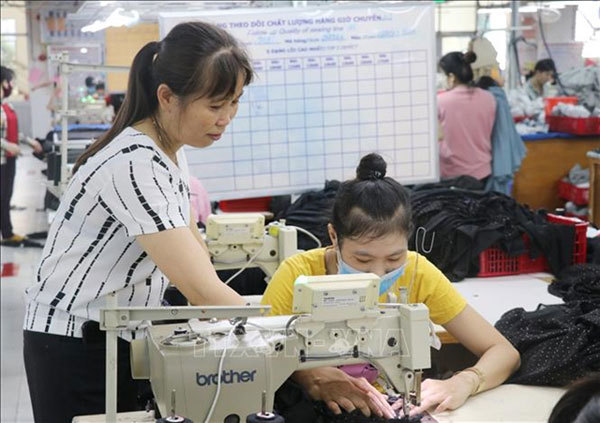 |
|
Van Thi Xuan Lan guiding a sewing worker.
|
Van Thi Xuan Lan is deputy director of An Hung Garment Factory in Tuy Hoa City, and she knows the struggles of poverty well.
Born in a poor family in Hoa Tri Commune, Phu Hoa District of Phu Yen, as a very young girl, Lan started working in tailoring to support her family.
After many years in the profession, in 1997, at the age of 21, she applied for a job at An Hung Garment Factory in Tuy Hoa.
With unceasing efforts, she earned several management positions from head of a sewing chain to deputy manager of a workshop.
An Hung Garment Factory specialises in outsourcing garments for fashion brands to export to Japan, the US and Europe.
Skills required
Skilled workers are needed to make fashionable clothes, but the factory was always short of qualified employees, as many workers quit shortly after being trained.
As a manager, Lan had to work out how to keep well-trained employees working at the factory in the long term.
“After months, I found a solution. I applied the model 'promote on-site job training' at the factory,” Lan said.
“Experienced workers and I directly tutored newly-recruited employees and made periodical assessments of the skills and development of each worker,” Lan said.
She also arranged workers in the sewing chains based on their level of skill, helping ease the pressure on workers so they didn't want to quit, she said.
“The workers still continued to receive training during their working in the factory to increase their skills and productivity,” she said.
Once they had teams of highly skilled workers, she proposed the factory’s leaders innovate production chains to improve productivity and product quality and increase workers' income as well.
Tran Thi My Trang, who has worked at the factory for five years and is a deputy manager of a workshop, said: “I was grateful for Lan’s tutoring."
“Previously, I worked at home as an amateur tailor which brought me a small and unstable income,” Trang said.
“When I joined the factory, I had basic sewing techniques. But after a few months of tutoring from Lan, I mastered many difficult techniques to make fashionable clothes,” she said.
Stable jobs and incomes helped the factory keep employees for longer terms and also attract more new workers.
The average income of a garment worker ranges from VND6 million to 10 million (US$260-430) per month, depending on the workers’ skill levels.
“It was difficult to train a good employee but keeping them wholeheartedly contributing to the company was even more difficult,” Lan said.
“At work, along with the responsibilities and attention of managers, good employees also need guaranteed income and adequate benefits,” said Lan.
“This was a prerequisite for them to decide whether to work for the company for a long time or not,” she added.
Since earlier this year, the COVID-19 pandemic has pushed many businesses into difficulties but Lan’s factory still receives many orders.
With many years of experience, Lan has researched and successfully applied initiatives to increase productivity for the factory.
The most prominent is the initiative of using a one-needle steam tube in the sewing stage to triple sewing productivity and cut labour costs, helping the factory save billions of dong.
Thanks to her dedication, Lan, a poor girl-turned-to-deputy director, received a Certificate of Merit from then Prime Minister Nguyen Tan Dung in 2015. VNS

VN textile and garment industry warned of big difficulties
The Covid-19 epidemic which broke out six months ago has seriously affected textile and garment companies.

Garment, textile industry gradually loses its advantages
Export target of US$40 billion of garment and textile industry this year is on the verge of failing to achieve due to several difficulties, such as a shortage of orders and high dependence on imported materials.